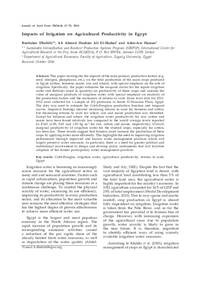Impacts of Irrigation on Agricultural Productivity in Egypt

Authors:
This paper investigates the impacts of the main primary production factors (e.g. seed, nitrogen, phosphorus, etc.), on the total production of the main crops produced in Egypt (cotton, berseem, maize, rice and wheat), with special emphasis on the role of irrigation. Specifically, the paper estimates the isoquant curves for the inputs irrigation water and fertilizer (used in quantity) on productivity of these crops and assesses the value of marginal products of irrigation water with special emphasis on elasticity of the production factors and the economics of returns to scale. Farm level data for 2011- 2012 were collected for a sample of 152 producers in South El Husainia Plain, Egypt. The data was used to estimate the Cobb-Douglass production function and isoquant curves. Empirical findings showed increasing returns to scale for berseem and cotton, but decreasing returns to scale for wheat, rice and maize production was identified. Except for berseem and wheat, the irrigation water productivity for rice, cotton and maize have been found relatively low compared to the world average levels reported by FAO (1.09, 0.65 and 1.80 kg m-3 for rice, cotton and maize, respectively). Overall, marginal productivity of irrigation water for the studied crops, especially for cotton, has been low. These results suggest that farmers could increase the production of these crops by applying water more efficiently. This highlights the need to improving irrigation performance through improved and known water management practices which will largely preserve water resources. In particular, there is a need for greater political and institutional involvement to design and develop policy instruments that will facilitate adoption of the farmer participatory water management practices.
